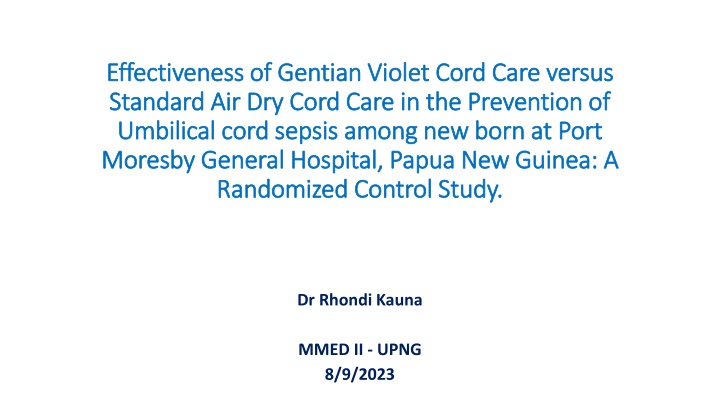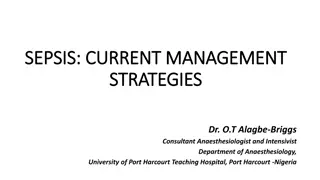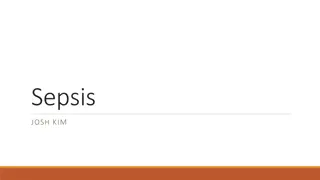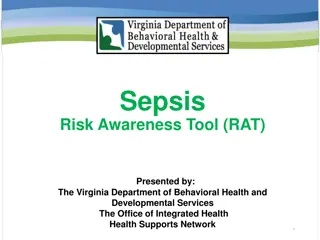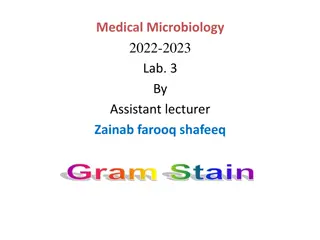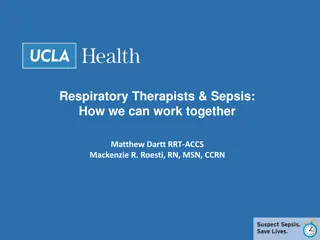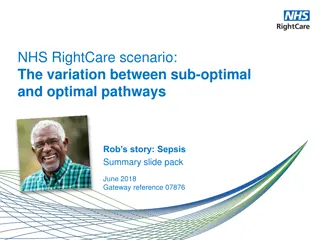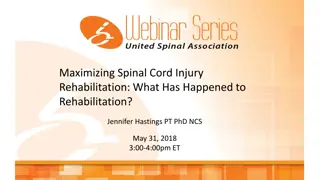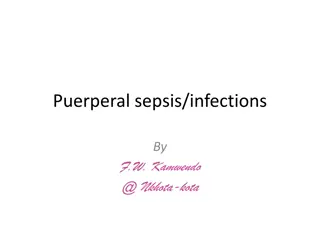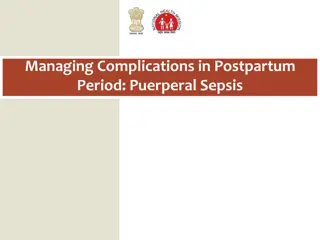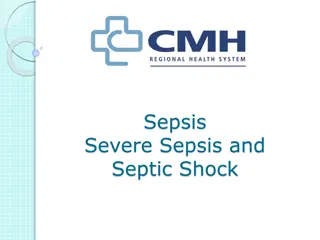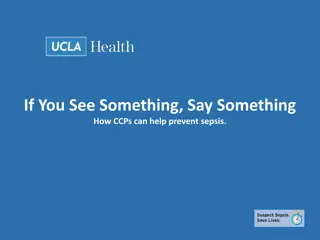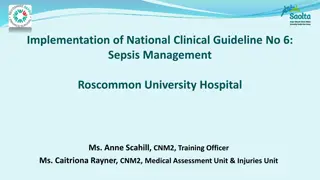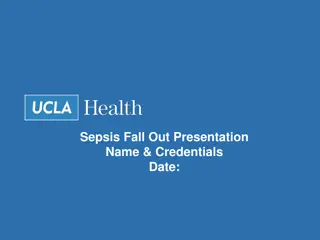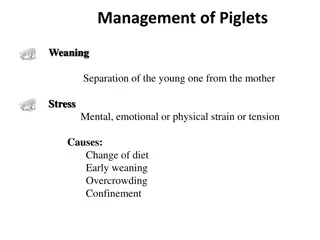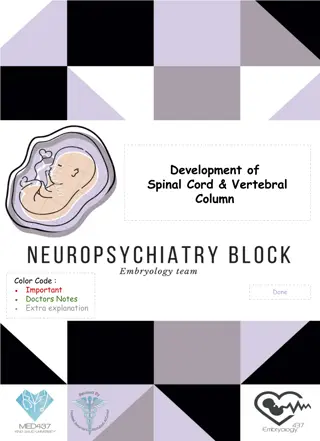Effectiveness of Gentian Violet Cord Care in Preventing Umbilical Cord Sepsis
This study compares the effectiveness of Gentian Violet cord care versus standard air-dry cord care in preventing umbilical cord sepsis among newborns at Port Moresby General Hospital, Papua New Guinea. The aim is to reduce neonatal mortality associated with neonatal cord sepsis.
Download Presentation

Please find below an Image/Link to download the presentation.
The content on the website is provided AS IS for your information and personal use only. It may not be sold, licensed, or shared on other websites without obtaining consent from the author.If you encounter any issues during the download, it is possible that the publisher has removed the file from their server.
You are allowed to download the files provided on this website for personal or commercial use, subject to the condition that they are used lawfully. All files are the property of their respective owners.
The content on the website is provided AS IS for your information and personal use only. It may not be sold, licensed, or shared on other websites without obtaining consent from the author.
E N D
Presentation Transcript
Effectiveness of Gentian Violet Cord Care versus Effectiveness of Gentian Violet Cord Care versus Standard Air Dry Cord Care in the Prevention of Standard Air Dry Cord Care in the Prevention of Umbilical cord sepsis among new born at Port Umbilical cord sepsis among new born at Port Moresby General Hospital, Papua New Guinea: A Moresby General Hospital, Papua New Guinea: A Randomized Control Study. Randomized Control Study. Dr Rhondi Kauna MMED II - UPNG 8/9/2023
Background Background Umbilical cord provides the pathway of blood transport from the placenta to fetus and vice versa. After delivery, the umbilical stump falls off to become the umbilicus. The newly cut, umbilical cord can be a pathway for bacteria causing sepsis and death. Umbilical cord hygiene prevents sepsis which is a leading cause of neonatal mortality. WHO recommended the use of 7.1 % chlorhexidine (CHX) for cord care in low resource settings like Papua New Guinea (PNG) and standard air-dry cord care in high-income hospital settings. In PNG, however, CHX for some reason is not readily available but Gentian Violet (GV) is readily available in many health facilities. GV has anti-bacterial, anti-fungal, anti-tumor, anti-helminthic and anti-angiogenic properties. However, there is limited studies done on the use of GV in umbilical cord care in under developed high neonatal mortality settings, including PNG. Alexander M Maley et al. (2015); Patricia S Coffey et al. (2017)
Aim of the study Aim of the study Determine the development of neonatal cord sepsis (NNCS) in both GV cord care and standard air-dry cord care groups Effectiveness in the safety and efficacy of GV in the management of cord care to standard air-dry cord care so as to help prevent incidence and reduce neonatal mortality associated with NNCS.
Methods and materials Methods and materials Study design Randomized Control Trial Study site PMGH labor ward and post natal ward Study duration August 2021 to February 2022 ( 7 months) Sample size 1000, GV group = 500 & Standard air-dry cord care group = 500 Sampling method Double Blind Randomization Data analysis Microsoft Word Excel -NNT / RR / ARR / RRR Ethical clearance Approved by SMHS/UPNG Consent Signed by mothers to take part in the study
Inclusion criteria Exclusion criteria Babies born in PMGH labor ward Born outside of PMGH Babies < 24 hours old Babies > 24 hours old Catchment area within the city Catchment area away from the city Babies of all weights and gestational age Babies with congenital anomaly like gastroschisis Not sick babies upon delivery GV cord care applied before recruitment Developed NNCS and needed antibiotics Babies born to mothers with maternal fevers Sick neonates upon delivery / needed oxygen therapy
Procedure Procedure 1. Identifying neonatal cord sepsis (NNCS) Foul odor / purulent discharge / blood stained / crusty cords Erythema of the cord extending to the surrounding umbilical region Systemic features of infection such as fever / hypothermia / poor feeding / abdominal distension. 2. NNCS was confirmed by Experienced pediatric NO / pediatric RMO / pediatric SMO in post-natal ward. Daily GV applied to babies with stable (no signs of systemic illness) NNCS for 7/7 Admitted for IV antibiotics for babies with NNCS with systemic illness for 5-7 days. 3. Follow ups & Discharging criteria after treatment F/ups D1, D3, D7, D14 & D21 Babies do not have any signs and symptoms of NNCS After 3/7 Cord fell off and dried around the stump Breast feeding well with no systemic signs and symptoms of illness
1000 babies recruited Results Results 237 excluded 763 included Standard Air Dry (group 2) = 372 GV (group 1) = 391 LTF = 23 LTF = 41 331 368 77 = NNCS 347 = No NNCS 21 = NNCS 254 = No NNCS
GV cord care group GV cord care group Table 1 showed that even with Gentian Violet cord care, risk of developing neonatal cord sepsis was high in babies who applied stat GV for cord care. 71% (15/21) had stat GV application only upon recruitment.
Table 2 Number of days took to develop NNCS. 86% (66/77) in group 2 and 76% (16/21) in group 1 developed early onset NNCS. Poor cord care knowledge Cord tucked inside diapers Poor sanitation Too sick moms Semi sterile delivery techniques (covid 19 2nd wave) Level of education grades 0-10 (moms)
Signs and symptoms of NNCS Signs and symptoms of NNCS Table 3 NNCS signs and symptoms presented with in the study. The GV paint itself can cause difficulty in identifying easily some symptoms and signs in GV cord care group such as; Redness around the cord stump or umbilical region. Blood-stained cord if the painted umbilical cord was too thick. Greenish stained cord
Types of treatment sought for neonatal cord sepsis Types of treatment sought for neonatal cord sepsis NNCS Rx GV group % Standard air-dry % Table 4 showed types of treatment received in both groups GV 18 86 65 84.4 Admit for iv antibiotics 3 14 8 10.4 Basically that GV cord care is still very effective in the treatment of stable NNCS (no signs and symptoms of systemic illness). Oral antibiotics 0 0 0 0 Antibiotic cream / povidone 0 0 4 5.2 Total 21 100 77 100 The OR of the cord infection in the GV paint intervention group is 0.20 (95% CI 0.12- 0.33)
Table 5 showed method and place of review. GV cord care group Standard air-dry cord care group NNCS (n=21) No NNCS (n=347) NNCS (n=77) No NNCS (n=254) 18% (14/77) & 5% (1/21) were reviewed passively, stable NNCS was diagnosed by; Reviewed via CED/NNC/PN W/SCN 4 37 13 30 1. After D3 f/up, if develop NNCS and r/v over phone, primary outcome would be ascertained Reviewed only via phone 1 80 14 152 Reviewed at PMGH and via phones 16 230 50 72 2. Accuracy of mother s assessment of NNCS over phone? Total 21 347 77 254
Table 6 summarizes all tables above Group 1 - GV Group 2 Standard air dry NNCS n (%) 21/368 (5.7%) 77/331 (23%) No NNCS n (%) 347/368 (94%) 254/331 (77%) Lost to f/up rate (%) 5.9% (23/391) 11% (41/372) 8.4% (total) Relative risk (RR) 0.057 0.233 0.24 (CI 0.14- 0.40) Relative risk reduction (RRR) - - 76% Absolute risk reduction (ARR) - - 0.16 Numbers needed to treat (NNT) - - 6.25
Discussion Discussion This study determined the effectiveness of GV in the use of cord care in under developed settings compared to standard air dry cord care; GV paint intervention is associated with 76% reduction (ARR) of stable NNCS compared to standard air drying if applied daily for 5/7 16% lower risk of developing NNCS if treated with daily GV for 5/7 Apply GV to 7 babies in order to prevent 1 NNCS Stat GV for cord care does not help reduce incidence and neonatal mortality associated with NNCS. There is limited studies on GV paint cord care
Limitations Limitations Primary outcome was ascertained at 48-72 hours were most of the follow up numbers were low around that time and very few at 7 days. The accuracy of mother s assessment of cord infection and their ability to communicate this over the phone. Mothers ability to assess the presence of cord infection with GV paint covering the cord Phone call or active r/v; Difficult / costly / tiring / long for 1 person / no funding No contacts / relatives or friends contact numbers Difficult for active r/v (covid pandemic 2nd wave) / risky NCD settlements / man power issues
Conclusion Conclusion GV paint intervention proved to be highly effective (ARR 76%) at reducing stable NNCS if applied daily for 5/7. Management of stable NNCS babies in both groups improved better with daily or alternate day GV application to the cord. Study proved the efficacy and safety of GV cord care in reducing incidence and neonatal mortality associated with stable neonatal cord sepsis. GV is readily available in aid posts, clinics and hospitals. It is less expansive and easy to use with minimal side effects.
Acknowledgement Thanking; God Dr Francis Pulsan Professor Trevor Duke Dr Gamini Vali Dr Aina Anota Sr Salome Pet and nurse Maureen Vilivili Thanking all staff of PMGH special care nursery and pediatric team in post-natal ward who worked in 2021 to 2022
References References 1. Alexander M Maley, Jack L Arbiser. Gentian Violet: A 19th Century Drug Re-emerges in the 21st Century. HHS Public Access Author Manuscript PMC 2015.https://www.ncbi/nlm.nih.gov/pmc/articles/PMC4396813 2. Patricia S Coffey, Siobhan C Brown. Umbilical cord care practices in low and middle income countries: a systemic review BMC Pregnancy and Childbirth 2017. 3. Shams E Arifeen, Luke C Mullany, Rashduzzaman Ahah, Ishtiaq Mannan, Syed M Rahman, Nazma Bugum, Nhamed Al-Kabir, Gary L Darmstadt, Muthuram Santosham, Robery E Black, Abdullah H Baqui. The Effect of cord cleansing with chlorhexidine on neonatal mortality in Rural Bangledesh: a community-based cluster randomized trial. Lancet 2012. 4. Zupan J, Gerner P, Omari A. A Topical umbilical cord care at birth.Cochrane Database Systemic Review 2004. 5. Luke C Mullany, Gary L Darmstadt, SUbarna Khatry, Joanne Katz, Steven LeClerq, Shardaram Shrestha, Ramesh Adhikari, James Tielsch. Topical applications of chlorhexidine to the umbilical cord for prevention of omphalitis and neonatal mortality I Southern Nepal: a community -based, cluster- randomized trial, Lancet 2008. 6. Docampo, Roberto, Silvia NJ, Moreno. The metabolism and mode of action of gentian violet. Drug metabolism reviews. 1990; 22:161 178. [PubMed: 2272286] 7. Bugaje, Mairo Adamu; et al Omphalitis (PDF). Pediatric Surgery: A Comphrehensive Text for Africa. 2013
